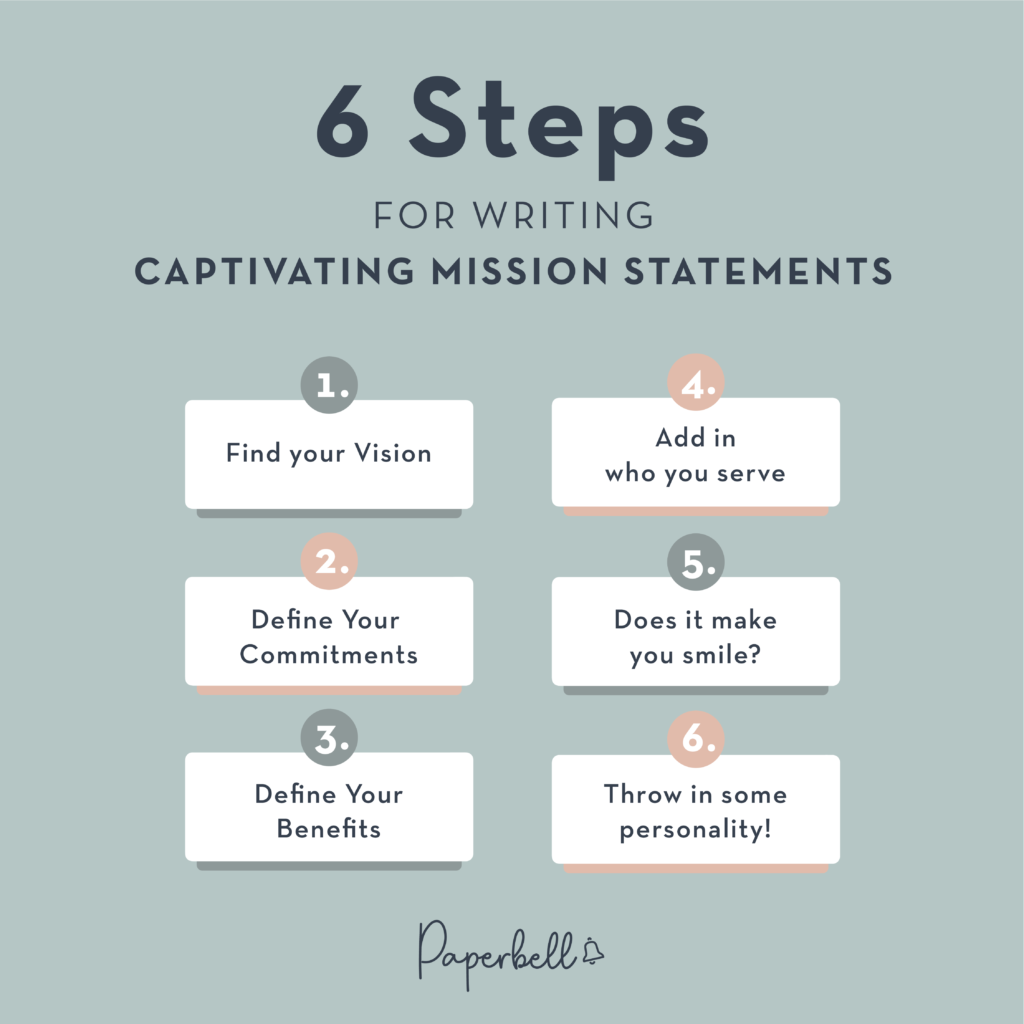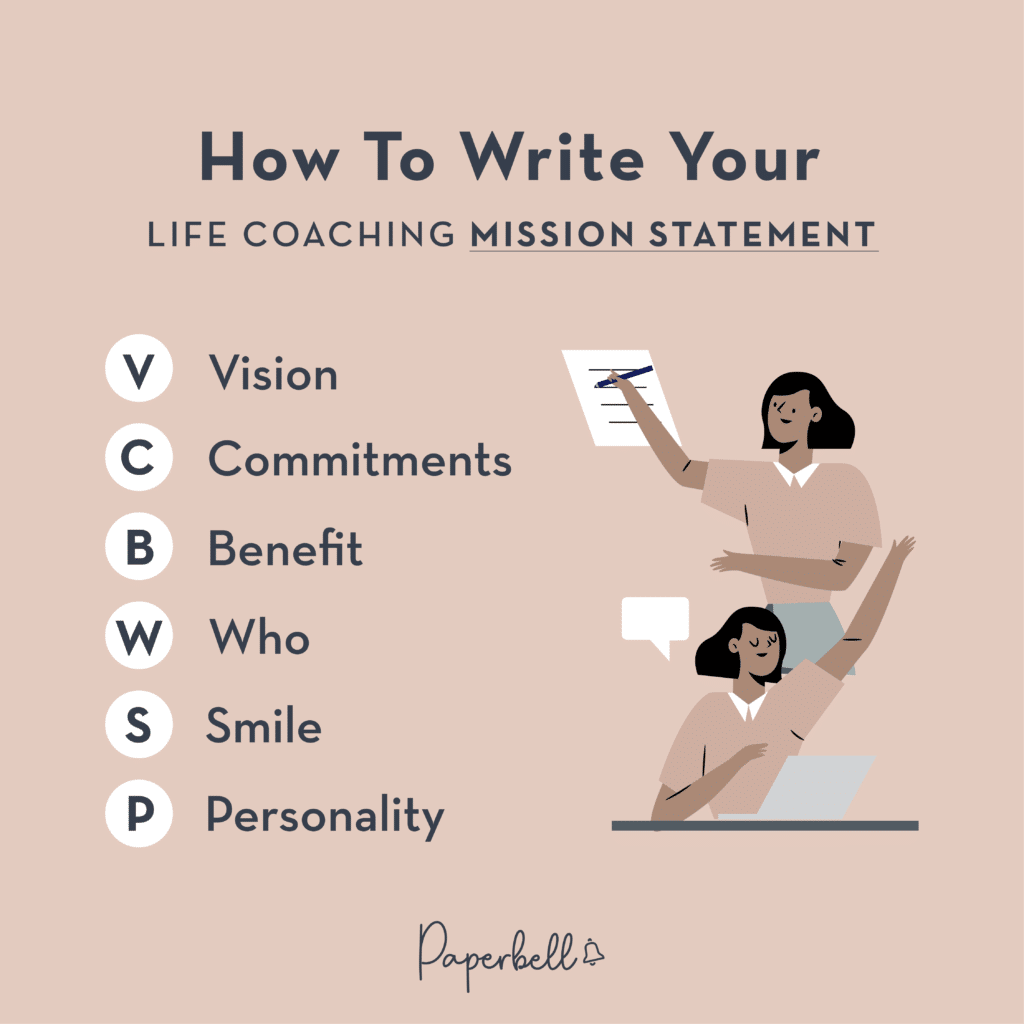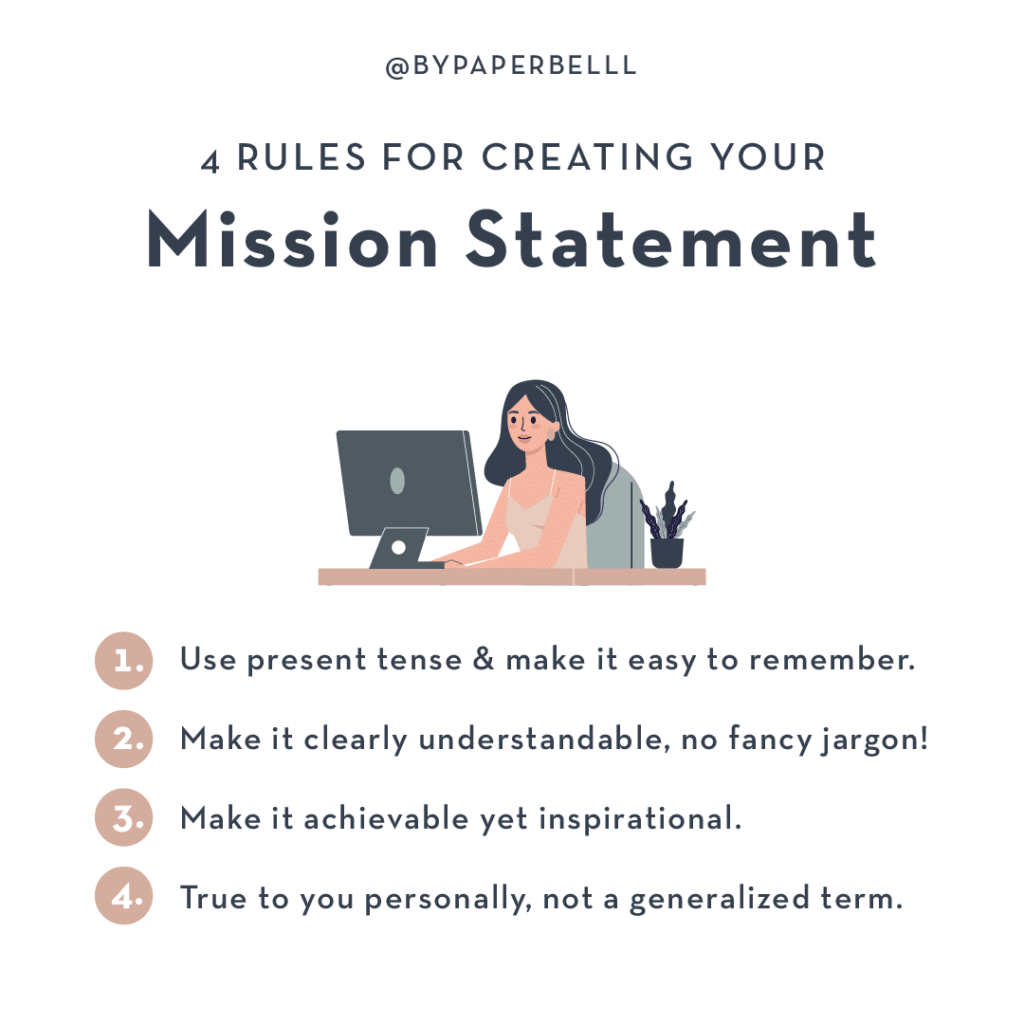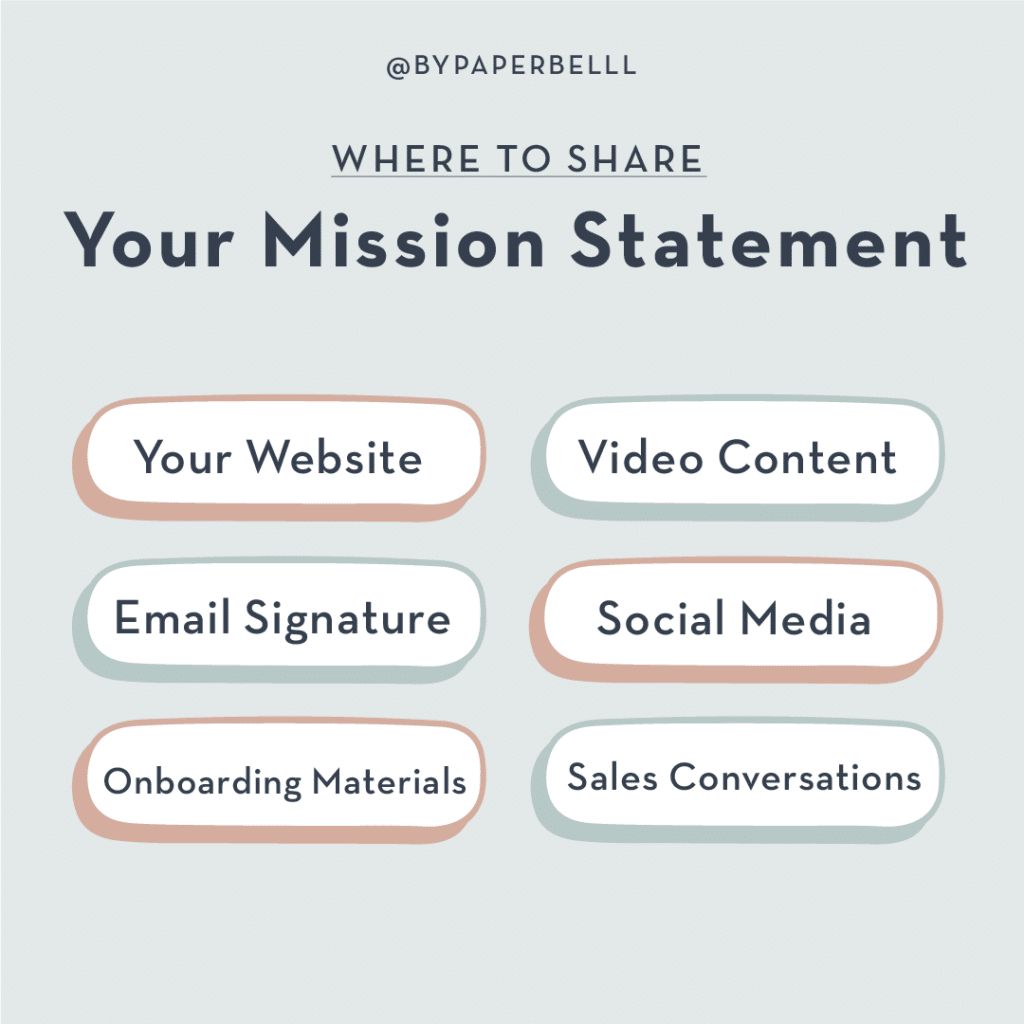If I were to ask you what your life coaching mission statement is, would you get sweaty palms?
Here’s the good news: If you said “yes,” you’re not alone; it is absolutely fixable. Here’s the better news: Once you are clear on your mission statement, you’ll connect much more deeply with potential clients, convert them more easily, and attract new clients who are a good fit for your business.
All this from a mission statement? YES! Read on to see how you can craft one that will set you apart effortlessly and position your services as a gotta-have-it-now purchase.

But First, What Is a Mission Statement?
Some of you might have heard of the term “vision” or “vision statement” before. I must warn you: mission and vision statements are not the same.
Your mission statement is all about what you do now to make your future visions come true. It’s what you are committing to do right now. On the other hand, a vision statement is focused on the future you hope to create.
It’s important to have both because they will inspire you, your team, and clients in different ways. The mission statement inspires you to act now, while the vision statement inspires what you become or create later.
How to Write Your Life Coaching Mission Statement
Here’s a simple formula I follow to write powerful mission statements.
Mission Statement = V+ C + B + W + S + P
V= Vision
C= Commitments
B= Benefit
W= Who
S= Smile
P= Personality

Let’s Break down How to Write Your Mission Statement, Step-by-step.
Make sure your mission statement has the following features:
- It uses the present tense. And is easy to remember.
- It is clear enough so that anyone could understand it. No fancy jargon!
- It should be achievable for your company.
- It should feel inspirational to you.
- It should feel authentic to you and all you stand for internally. Craft it so that it is true for you and is not written based on what you think you should say or what others might say.
Step 1: Find your vision (V)
Ask yourself the ultimate vision for your business, the people it serves, your industry, and the world. I like asking my clients…
What achievements do you hope to have accomplished in the future?
What type of world do you want to live in related to what you do?
What would excite you to have achieved in the future? What do you hope you can help end (or begin)?
If I gave you a microphone right now that magically let you talk to everyone who was your perfect-fit client, what would you want to share with them?
What would you want them to stop doing or start doing? What would you want for them?
Why does your business exist?
What is the big thing you are fighting against? Ignorance? Stereotypes? Unhappiness?
Thinking of these answers will help form your vision for the future.
Step 2: Define your commitments (C)
From that vision, work backward and think of the major objectives you need to commit to doing now to have that future for yourself, your clients, your industry, and the world.
These are the things you are committed to doing daily for your clients.
Step 3: Define your benefits (B)
Add in the amazing things people get from working with you.
What’s the benefit of your work to your clients? Who will they be, or what will they have due to their work with you?
An easy way to show the benefit is to use the phrase “so that.”
Step 4: Add in who you serve (W)
Think of something your clients have in common. It might be…
A certain experience (such as they are all moms, divorced, or have lost a job)
A belief (such as they believe all body shapes are beautiful)
Values (such as being family-oriented or mission-driven)
Or a concern (such as they all want to end poverty)
If you’re a local business, it could also be that they all live in the same area and are part of the same local community.
Step 5: Does it make you smile? (S)
Review your list of what you wrote down and cross off anything you wrote that sounds similar to another sentence you’ve written or just doesn’t seem doable.
Cross out anything that doesn’t light you up or bring you energy. When you read it, it should make you smile.
Step 6: Throw in some personality (P)
You could say you help clients. But for a little more personality, you could say you help them overcome a certain experience or design a life of so and so.
You could say you help clients gain confidence, or for more personality, you could help them find their inner warrior.

Life Coach Mission Statement Examples
Here are a few examples of coaching mission statements you can draw inspiration from. Notice how they all follow the mission statement formula shared above?
Let’s say you are a life coach who works with women after divorce. You might say:
I’m committed to…
- Providing women with coaching services that rebuild their confidence after divorce.
- Delivering my services with sincere integrity.
- Ensuring my clients feel welcome and valued, regardless of their gender, ethnic, social, or religious background.
If you’re a life coach for millennials having a quarter-life crisis, you might say:
I’m committed to…
- Guiding millennials through a quarter-life crisis so that they can find balance, success, and personal fulfillment in their careers and relationships.
- Showing compassion to every client and providing resources and tools that give them the clarity they need.
- Helping clients overcome the frustration of a quarter-life crisis and showing them how to turn it into a life-changing opportunity.
If you are a confidence coach, you might say:
I’m committed to…
- Helping middle-aged women remember their worth at work and at home.
- Giving tools for my clients to help them find their voice, and to feel heard and respected.
As you can see, these coaching mission statement examples are 2-3 sentences long and they clearly express whom you serve and how. You could use the first bullet point of each mission statement, but the additional points help create a fuller picture.
Where to Share Your Mission Statement

So, you have a mission statement. Now what? Here are a few places that are perfect spots to begin sharing it:
- Your coaching website
- Your email signature
- Your social media posts
- Your videos (as part of your video introduction or as a standalone video)
- In the onboarding materials you send to clients (for example, your automated emails in Paperbell)
- As a part of your sales conversations
1. Your Coaching Website
Your coaching website is like a digital business card, and it’s the first place you should showcase your mission statement. Include it in your hero section (the top of your home page, your “About Me” page), or create a dedicated section showcasing your mission and philosophy.
This is often the first point of contact for potential clients, and a well-crafted mission statement can immediately resonate with those seeking your services.
2. Your Email Signature
Infuse your professional emails with inspiration by incorporating your mission statement into your email signature. This subtle yet effective placement ensures that every communication with clients, collaborators, or prospects carries the essence of your coaching mission.
3. Your Social Media Posts
Social media platforms like LinkedIn and Instagram are great places to share your mission statement. You can create quote posts with your mission statement, or capture reels where you explain where your mission comes from to your followers.
4. Your Videos
Besides social media reels, you can also film a full-blown introduction video for your website or a longer vlog for YouTube. Video content allows you to convey the passion and sincerity behind your mission, creating a more personal connection with your audience.
5. Onboarding Materials Sent to Clients
Make your mission statement a part of the onboarding process for new clients. Whether integrated into automated emails through platforms like Paperbell or included in welcome packets, reinforcing your mission from the beginning sets the tone for your coaching relationship.
6. Sales Conversations
Weave your mission statement into your sales conversations to give potential clients a deeper understanding of your approach. This helps align expectations and establishes a sense of trust and shared values, crucial elements for a successful coaching relationship.
Over to You
A strong mission statement for your business can help set you apart from other coaching professionals. It can also help you win clients in sales conversations by showing them how your coaching services will benefit them and how what you do is different from other similar services on the market.
Don’t rush writing your mission statement. If done well, this can become an integral part of your marketing and branding efforts for years to come, so make sure it feels authentic.
Your life coaching mission statement will help you connect with the right clients and make the change in the world you have always wanted to make. And when you’re ready to upgrade your entire coaching business, check out Paperbell. It’s an all-in-one client management software that handles your payments, scheduling, contracts, packages, landing pages, and more. You can sign up and claim your free account here.

Editor’s Note: This post was originally published in March 2021 and has since been updated for accuracy.








